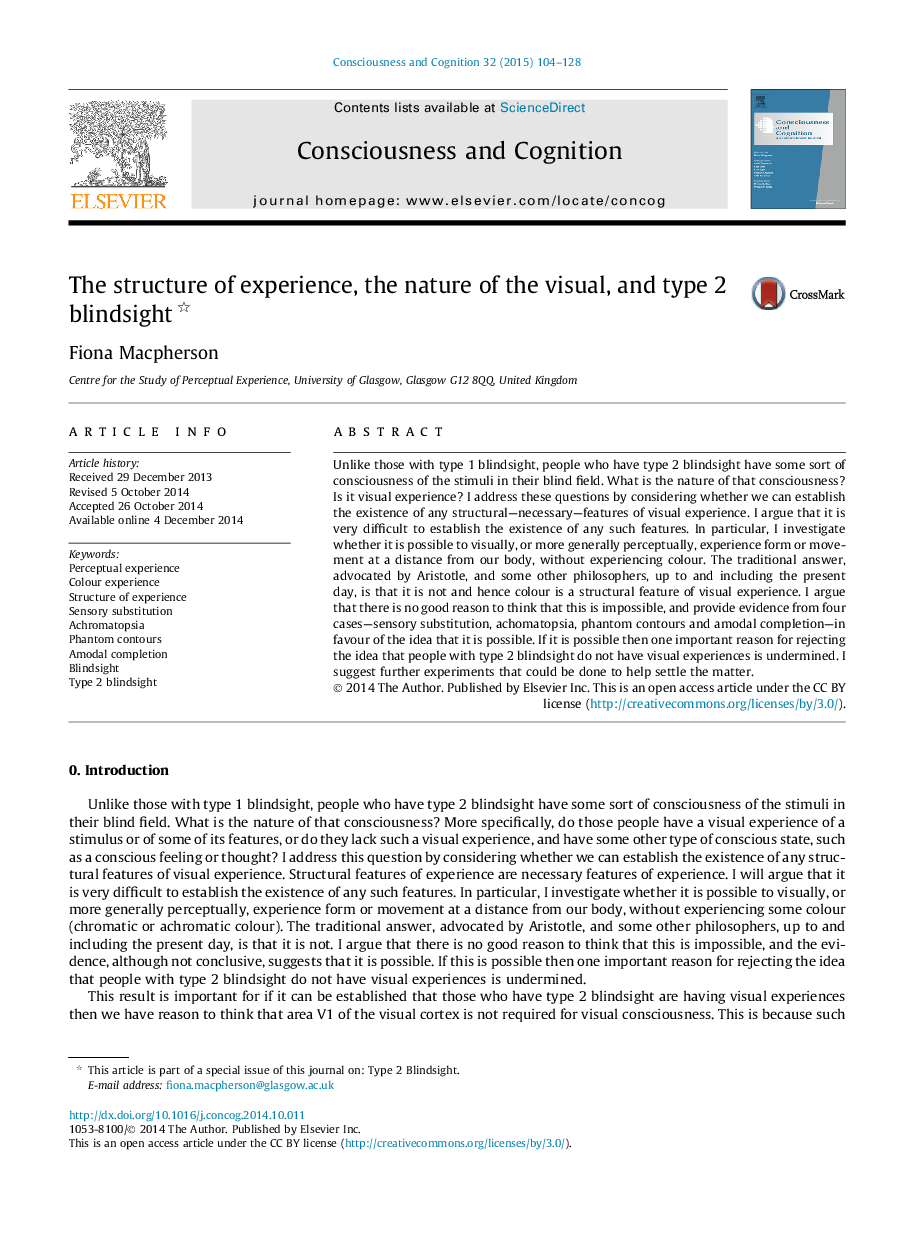| کد مقاله | کد نشریه | سال انتشار | مقاله انگلیسی | نسخه تمام متن |
|---|---|---|---|---|
| 7289553 | 1474179 | 2015 | 25 صفحه PDF | دانلود رایگان |
عنوان انگلیسی مقاله ISI
The structure of experience, the nature of the visual, and type 2 blindsight
ترجمه فارسی عنوان
ساختار تجربه، ماهیت بصری، و نوع 2 کور چشم انداز
دانلود مقاله + سفارش ترجمه
دانلود مقاله ISI انگلیسی
رایگان برای ایرانیان
کلمات کلیدی
ترجمه چکیده
بر خلاف کسانی که با نوع کورکورانه نوع 1، افرادی که نوع 2 کورکورانه دارند، نوعی آگاهی از محرک ها در زمینه کور هستند. ماهیت آن آگاهی چیست؟ آیا این تجربه بصری است؟ من به این سوالات با در نظر گرفتن اینکه آیا می توانیم وجود هر ویژگی ساختاری-ضروری تجربه بصری را ایجاد کنیم، پاسخ می دهیم. من استدلال می کنم که وجود چنین ویژگی هایی بسیار دشوار است. به طور خاص، من بررسی می کنم که آیا ممکن است به صورت بصری، یا عموما درک عمیق تر، تجربه شکل یا حرکت در فاصله ای از بدن ما، بدون تجربه رنگ. پاسخ سنتی که توسط ارسطو و برخی از فیلسوفان دیگر مطرح شده است تا آنجایی که امروزه به آن پرداخته شده است این است که این موضوع نیست و بنابراین رنگ یک ویژگی ساختاری تجربه بصری است. من استدلال می کنم که هیچ دلیلی وجود ندارد که فکر می کنم این غیرممکن است و شواهدی از چهار جایگزین حسی، آئوماتوپسی، کانون های فانتوم و تکمیل آمودال وجود دارد - به نفع این ایده که ممکن است. اگر این امکان وجود داشته باشد، یک دلیل مهم برای رد کردن این ایده که افراد مبتلا به نوع 2 کورکورانه تجربیات بصری ندارند، تضعیف می شود. من توصیه های بیشتری را می توانم انجام دهم تا بتوانم مسئله را حل کنم.
موضوعات مرتبط
علوم زیستی و بیوفناوری
علم عصب شناسی
علوم اعصاب شناختی
چکیده انگلیسی
Unlike those with type 1 blindsight, people who have type 2 blindsight have some sort of consciousness of the stimuli in their blind field. What is the nature of that consciousness? Is it visual experience? I address these questions by considering whether we can establish the existence of any structural-necessary-features of visual experience. I argue that it is very difficult to establish the existence of any such features. In particular, I investigate whether it is possible to visually, or more generally perceptually, experience form or movement at a distance from our body, without experiencing colour. The traditional answer, advocated by Aristotle, and some other philosophers, up to and including the present day, is that it is not and hence colour is a structural feature of visual experience. I argue that there is no good reason to think that this is impossible, and provide evidence from four cases-sensory substitution, achomatopsia, phantom contours and amodal completion-in favour of the idea that it is possible. If it is possible then one important reason for rejecting the idea that people with type 2 blindsight do not have visual experiences is undermined. I suggest further experiments that could be done to help settle the matter.
ناشر
Database: Elsevier - ScienceDirect (ساینس دایرکت)
Journal: Consciousness and Cognition - Volume 32, March 2015, Pages 104-128
Journal: Consciousness and Cognition - Volume 32, March 2015, Pages 104-128
نویسندگان
Fiona Macpherson,
